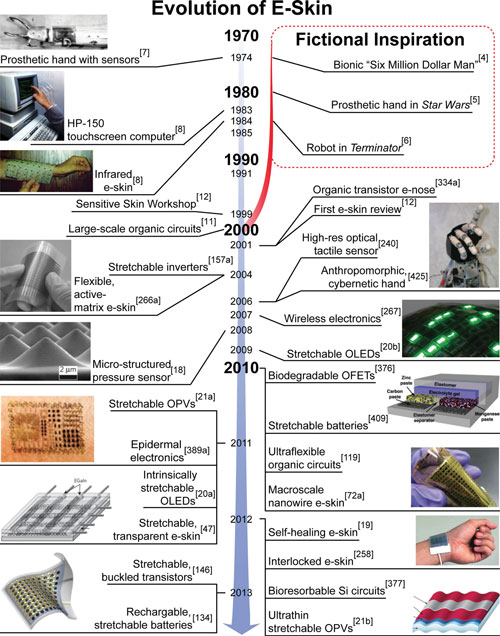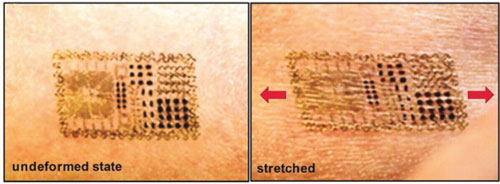| Posted: Nov 15, 2013 | |
Electronic skin - a primer |
|
| (Nanowerk Spotlight) Advances in materials, fabrication strategies and device designs for flexible and stretchable electronics and sensors make it possible to envision a not-too-distant future where ultra-thin, flexible circuits based on inorganic semiconductors can be wrapped and attached to any imaginable surface, including body parts and even internal organs. | |
| Robotic technologies will also benefit as it becomes possible to fabricate electronic skin ('e-skin') that, for instance, could allow surgical robots to interact, in a soft contacting mode, with their surroundings through touch. In addition to giving robots a finer sense of touch, engineers believe that e-skin technology could also be used to create things like wallpapers that double as touchscreen displays and dashboard laminates that allow drivers to adjust electronic controls with the wave of a hand. | |
| Human skin is a sensitive detector of both pressure and temperature. Efforts to develop similar sensors for electronics are widespread, and many of the tools are already well-known. In the past decade, the pace of e-skin development has accelerated dramatically owing to the availability of new materials and processes. As a result of this progress, the capabilities of e-skin are rapidly converging on those depicted in science fiction. | |
 |
|
| A brief chronology of the evolution of e-skin. (© Wiley-VCH Verlag) (click image to enlarge) | |
| A recent review article in Advanced Materials provides a brief history, design considerations and recent progress in the development of electronic skin. The effort was led by Zhenan Bao from Stanford University. Bao's group has been very active in the development of e-skin design (see for instance: "New stretchable solar cells will power artificial electronic 'super skin'"). | |
| After providing a brief chronology of the evolution of e-skin – including examples of popular science fiction literature – going back as far as the early 1970s, the authors discuss design considerations covering some of the materials and techniques frequently used for e-skin: "Human skin can be considered as a performance benchmark for the development of artificial tactile systems. Important considerations for the development of e-skin are the choice of materials used in its fabrication and the ability to confer the mechanical properties of human skin (low modulus, stretchability and flexibility) into its artificial counterpart." | |
| Relevant materials include carbon nanotubes, graphene, nanowires as well as organic and polymer-based active materials. An important characteristic of human skin is its ability to stretch and flex with bodily movements without incurring damage. While arrays of flexible electronics have been developed by using very thin plastic substrates (see for instance: "Electronic sensing with your fingertips"), stretchable devices have been more difficult to achieve, and new processes and materials are often required (read more: "Human-motion detection - nanotechnology takes interactivity to a new level"). In general, stretchable devices can be fabricated by developing devices comprised of intrinsically stretchable materials or by appropriate geometrical arrangement of conventional materials. | |
| The mechanical properties of skin have a pronounced effect on its tactile sensing capabilities. Developing highly sensitive tactile sensors therefore is one of the essential aspects of for e-skin designs. To illustrate this point, the authors list some of the essential aspects of life that are mediated by the multifunctional tactile sensing capabilities of skin: | |
|
|
|
| According to the authors, "the characteristics outlined above should be considered as the minimum requirements for e-skin that would allow for its interaction with the world in a human-like way." | |
| Another set of challenges is posed by the requirements arising from fabricating large-area flexible arrays needed for the batch production of e-skin. Many groups have turned to polymer micromachining, which is more cost effective and provides flexible devices. Polymer micromachining typically involves using photolithography or molding to pattern device structures, such as air gaps for capacitive sensors or resistive strain gauges. Large-area solution processing and printing technologies have gained popularity as low-cost, high throughput fabrication techniques. | |
 |
|
| Optical images of multifunctional epidermal electronic systems on unstretched (left) and stretched (right) skin. (© Wiley-VCH Verlag | |
| Finally, device integration and readout are required for functional device applications. Since tactile sensing requires a multitude of sensors distributed over a large area. Developing methods to collect and process such a large amount of information has been a persistent challenge in the field. | |
| In addition to the signal conditioning that can occur at the device level in transistor-integrated devices, data processing can also occur at an intermediate level to reduce the volume of data reaching the control computer. Bao and her team point out that this strategy is similar to human skin, where data collected from groups of neurons is processed en route to the brain: "Modular approaches involve creating arrays that can be subsequently combined to create an even larger array. By implementing computing capabilities into each module, signal processing or data analysis can occur within the sensor network itself. Modularity also provides the ability to expand a sensor network to meet the needs of any application." | |
| Having covered e-skin design issues with regard to tactile sensing functionality, the team then turns to the discussion of how e-skin can be augmented beyond the capabilities of human skin through the integration of chemical and biological sensors. | |
| "There is already high demand for miniaturized, portable, and inexpensive sensors for the monitoring of a broad range of compounds, including environmental pollutants, chemical and biological warfare agents, and medically relevant biomarkers. To meet this demand, electronically based chemical and biological sensors for gas (e.g., e-nose) and liquid (e.g., e-tongue) phase analytes have been demonstrated on rigid substrates using carbon nanotubes, graphene, inorganic nanowires, and organic materials as the active sensor element. The continued production of low-cost chemical and biological sensors via high-throughput techniques and translation of this technology onto flexible substrates will be attractive for integration with e-skin." | |
| The authors also address some additional desirable properties for e-skin such as biocompatibility and biodegradability, self-healing, temperature sensitivity, and self-powering. | |
| In the final section, they describe a number of recent advances in highly integrated systems of mechanically compliant sensor arrays possessing multiple functionalities and their demonstrated applications in the fields of biomedical devices, robotics, and optoelectronics. | |
| Concluding the review, the scientists point out one particular challenge for the future of e-skin – neural interfacing: "Work has already begun to overcome this obstacle, and recently, a neurally controlled robotic arm capable of 3D reach and grasp movements was reported. Additionally, a bionic ear has been demonstrated with the capability to receive RF signals beyond that of the human ear. The rapid pace of progress in e-skin technology suggests that the fabrication of a more complex e-skin with properties far surpassing those of their organic equivalent will soon be possible." | |
 By
Michael
Berger
– Michael is author of three books by the Royal Society of Chemistry:
Nano-Society: Pushing the Boundaries of Technology,
Nanotechnology: The Future is Tiny, and
Nanoengineering: The Skills and Tools Making Technology Invisible
Copyright ©
Nanowerk LLC
By
Michael
Berger
– Michael is author of three books by the Royal Society of Chemistry:
Nano-Society: Pushing the Boundaries of Technology,
Nanotechnology: The Future is Tiny, and
Nanoengineering: The Skills and Tools Making Technology Invisible
Copyright ©
Nanowerk LLC
|
|
|
Become a Spotlight guest author! Join our large and growing group of guest contributors. Have you just published a scientific paper or have other exciting developments to share with the nanotechnology community? Here is how to publish on nanowerk.com. |
|
